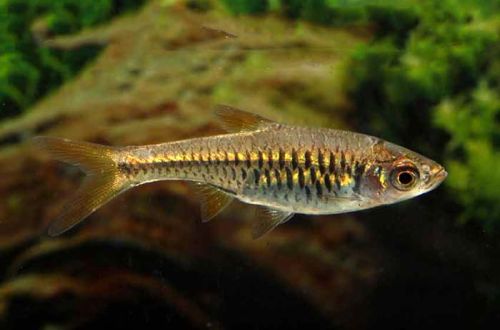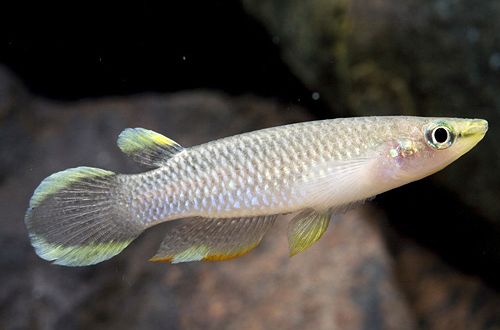
Boesman’s iris
Boesman’s Melanothenia or Boesman’s Rainbow, scientific name Melanotaenia boesemani, belongs to the Melanotaeniidae family. A relatively new species in aquariums, but has already become popular.

The fish was discovered in 1954 during a Dutch expedition by Dr. Marius Boeseman. Then reopened in 1982. At the same time, the first specimens of the new species were delivered to Europe and served as the basis for the creation of modern hybrid forms available for sale.
Contents
Habitat
Occurs from the western tip of New Guinea, also known as Irian Jaya or West Irian, on the territory of modern Indonesia. In nature, it is found only in three small lakes and their tributaries. Prefers shallow water regions with dense aquatic vegetation.
In their natural habitat they are endangered. Most of the fish for sale are grown on fish farms.
Brief information:
- The volume of the aquarium – from 110 liters.
- Temperature – 27-30°C
- Value pH — 7.0–8.0
- Water hardness – medium to hard (10-25 GH)
- Substrate type – any
- Lighting – subdued
- Brackish water – no
- Water movement is weak
- The size of the fish is 8–11 cm.
- Food – any food
- Temperament – peaceful, active
- Keeping a flock of at least 6-8 individuals
Description

Adults reach 8–11 cm in length. The coloration is variable, the head and front of the body are blue, fading to yellow-orange on the back and tail. Males are larger and have more intense coloration.
Food
Boesman’s iris is undemanding to the diet, it will accept all types of popular food – dry, live and frozen foods. The quality and composition of the food directly affects the color of the fish, so it is recommended to use products from well-known manufacturers and regularly (at least once a week) feed live food, such as brine shrimp or bloodworms.
Maintenance and care, arrangement of the aquarium
A flock of Boesman’s Melanotenia needs a small aquarium with a volume of 110 liters. The design is simple, it is enough to provide dense clusters of rooting and floating plants, located in such a way as to preserve free areas for swimming. The remaining elements of the decor are not critical and are selected at the discretion of the aquarist.

For fish that come from stagnant water bodies, excessive movement of water in the aquarium is undesirable. This should be taken into account when choosing and placing a filtration system – the main source of internal flow.
Behavior and Compatibility
A peaceful and active species, it goes well with other fish of comparable size and temperament, able to live in similar conditions. Keeping a flock of at least 6-8 individuals of both sexes. It is noted that males in the presence of rivals show more expressive coloring.
Breeding / breeding
The optimal conditions for reproduction are: hard and slightly alkaline (pH 7.5) water, with a temperature of 27–29°C, a diet rich in protein, the presence of small-leaved and low-growing plants or their artificial analogues.
The spawning period lasts about 2 weeks, during this time the female lays several eggs daily among the thickets of plants, attaching them with sticky threads to the surface of the leaves. The male can fertilize several clutches at once from different females. Parental instincts are not developed. At the end of spawning, the fish do not show concern for their offspring, however, they do not pose a threat to eggs and fry. What can not be said about other neighbors in the aquarium, who can eat eggs and fry.
In order to preserve the brood, the eggs can be carefully transferred to a separate tank with identical conditions, where they will be completely safe. The incubation period lasts from 7 to 12 days. In the first days of life, the fry will need microfeed, such as ciliates. As they mature from the first week, specialized powdered food and/or brine shrimp nauplius can be fed.
Fish diseases
Health problems arise only in case of injuries or when kept in unsuitable conditions, which depresses the immune system and, as a result, provokes the occurrence of any disease. In the event of the appearance of the first symptoms, first of all, it is necessary to check the water for the excess of certain indicators or the presence of dangerous concentrations of toxic substances (nitrites, nitrates, ammonium, etc.). If deviations are found, bring all values back to normal and only then proceed with treatment. Read more about symptoms and treatments in the Aquarium Fish Diseases section.
Source: FishBase





